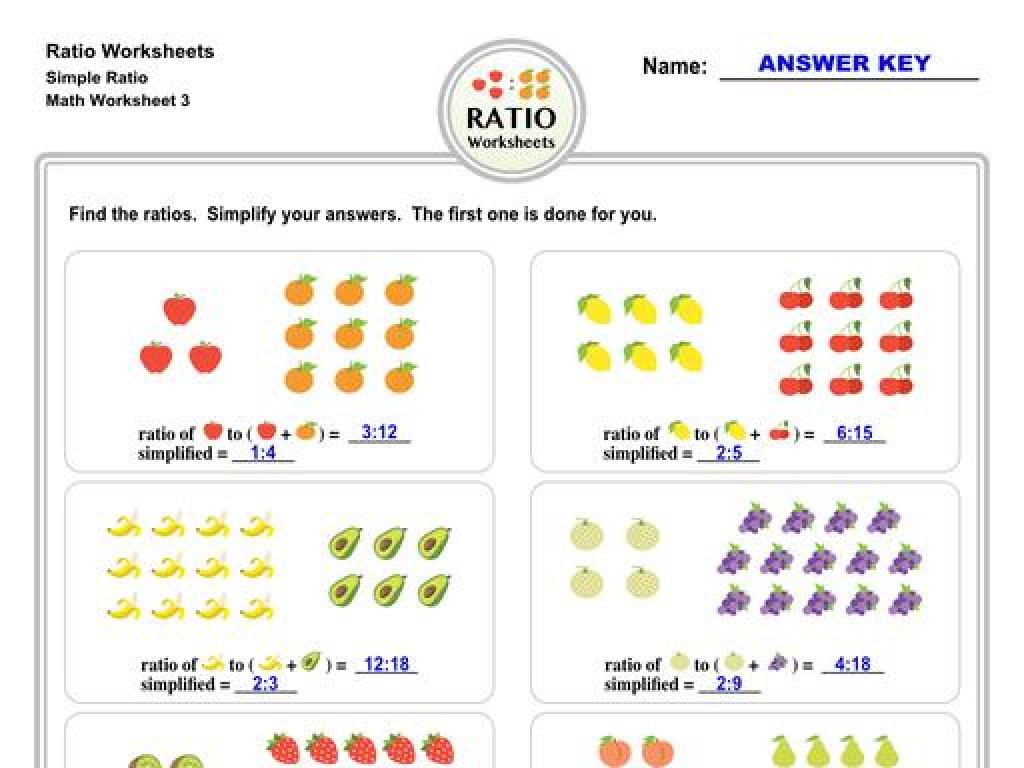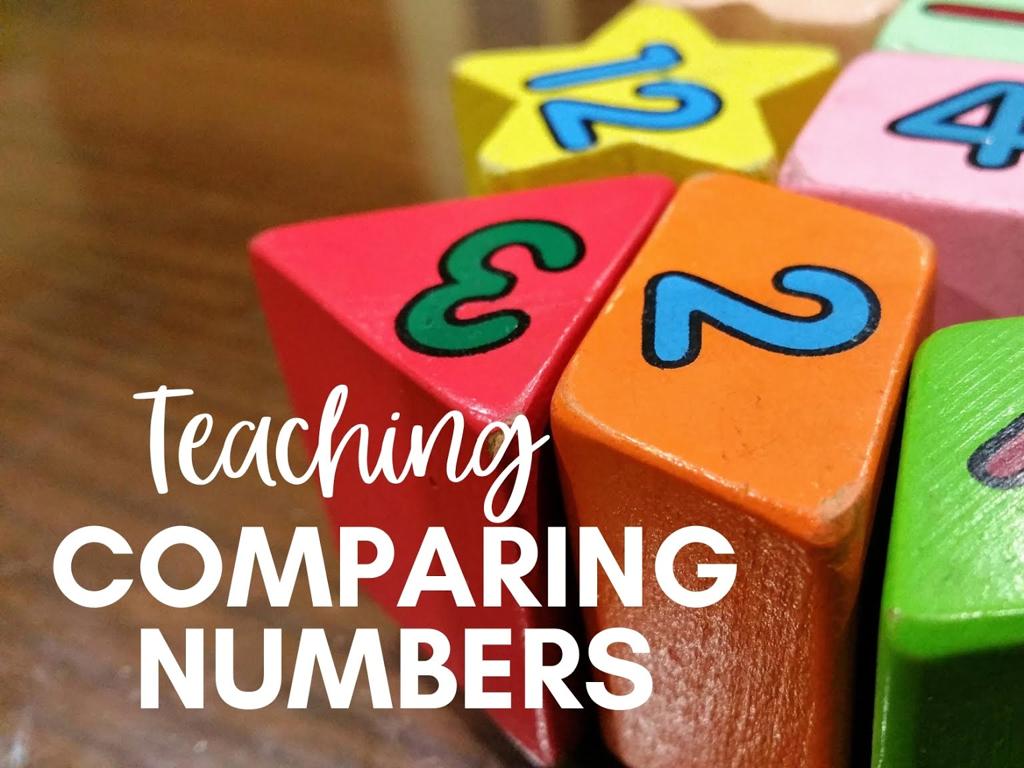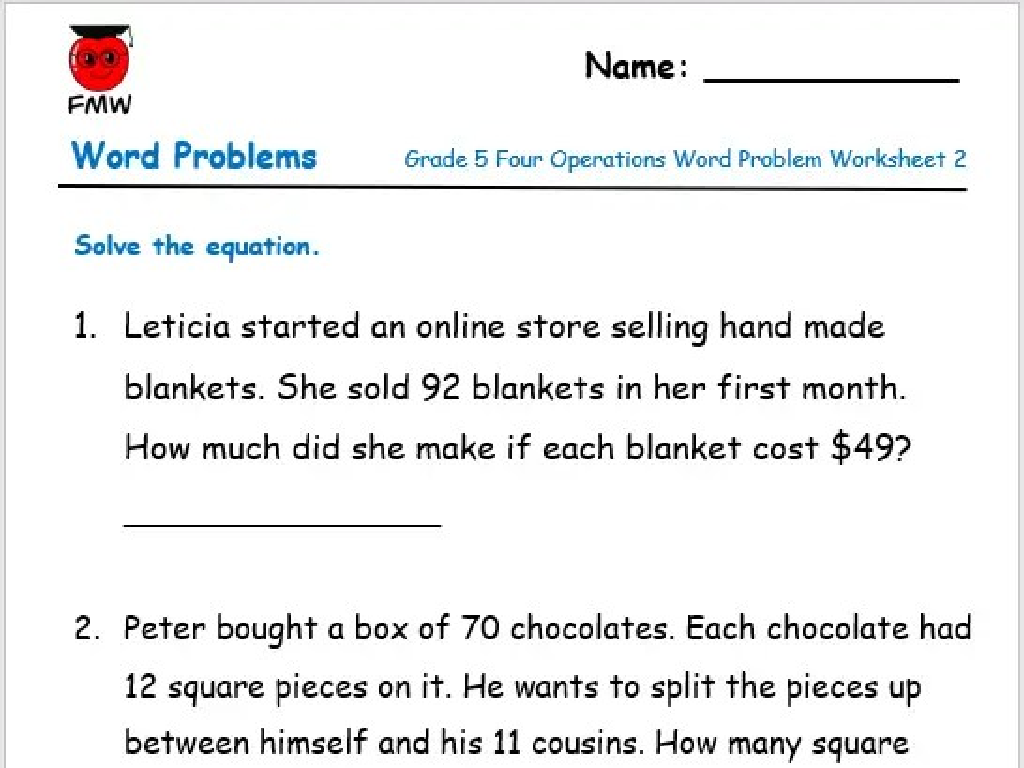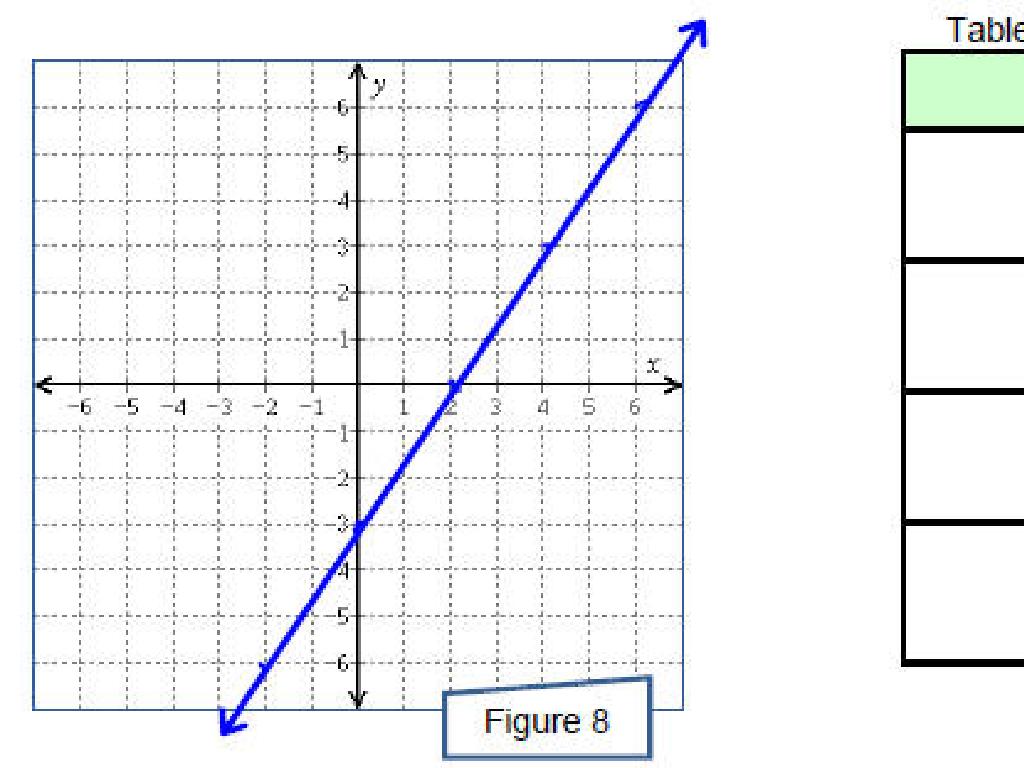Write A Ratio
Subject: Math
Grade: Sixth grade
Topic: Ratios And Rates
Please LOG IN to download the presentation. Access is available to registered users only.
View More Content
Welcome to Ratios!
– Understanding Ratios
– A ratio shows the relative sizes of two or more values.
– Ratios in everyday life
– Comparing ingredients in a recipe or speed of cars.
– Ratio terminology
– Terms like ‘to’, ‘for every’, and ‘per’ are used in ratios.
– Writing ratios correctly
– Ratios can be written as 3:1, 3 to 1, or 3/1.
|
Introduce the concept of ratios, which are comparisons of two quantities showing the relative sizes or amounts of each. Use everyday examples like recipes (e.g., 2 cups of flour to 1 cup of sugar) or speed (e.g., 60 miles per hour) to illustrate how ratios are part of daily life. Explain the language used in ratios, including terms such as ‘to’, ‘for every’, and ‘per’, which help describe the relationship between quantities. Teach students the different ways to write ratios, ensuring they understand that all forms represent the same comparison. Provide practice problems for students to write ratios from word descriptions and from actual items or quantities.
Understanding Ratios
– Definition of a ratio
– A ratio shows how two values compare
– Three ways to write ratios
– Ratios can be written as: 3 to 4, 3:4, or 3/4
– Examples in different formats
– For example, 3 to 4, 3:4, or 3/4 all represent the same ratio
– Practice with real-life ratios
– How many boys to girls in class? Or slices of pizza to people?
|
Introduce the concept of ratios, emphasizing that they are a way to compare two or more quantities. Explain that ratios can be written in different ways but represent the same relationship. Provide examples of ratios using all three formats to illustrate the concept. Encourage students to think of ratios they encounter in everyday life, such as the ratio of ingredients in a recipe or the ratio of pets to people in a household. Use the practice examples to help students apply their understanding of ratios to real-world situations, reinforcing the concept that ratios are all around us.
Writing Ratios
– Ratios using colon format
– Example: For every 3 apples, there are 5 oranges, written as 3:5
– Ratios written as fractions
– Same ratio as a fraction: 3/5
– Expressing ratios in words
– Described verbally: ‘three to five’ or ‘three out of five’
|
This slide introduces students to the concept of writing ratios in different formats. Start by explaining that a ratio is a comparison between two numbers showing how many times the first number contains the second. Use everyday examples to illustrate ratios in colon format, such as comparing apples to oranges. Then, show how to express the same ratio as a fraction, which is another common method in mathematics. Finally, demonstrate how to verbalize ratios, which is useful in everyday language. Encourage students to practice by writing ratios in these three formats using examples from their surroundings or from problems provided in class.
Understanding Ratios Through Examples
– Ratios in cooking recipes
– Recipe example: 2 cups of flour to 3 cups of sugar
– Classroom seating ratio
– If there are 20 desks and 10 students, the ratio is 2 desks per student
– Animal group ratios
– For every 5 cats, there are 10 dogs, so the ratio is 1:2
– Object grouping ratios
– Pencils to erasers in a pack might be in the ratio of 4:1
|
This slide aims to help students understand the concept of ratios by relating them to familiar situations. Start with cooking recipes, which often use ratios for ingredients. Move on to classroom settings, where ratios can determine the number of desks per student. Discuss ratios in groups of animals, which can help in understanding population dynamics. Lastly, talk about ratios in object groupings, such as the number of pencils to erasers in a pack. Encourage students to think of their own examples and understand that ratios are a way to compare quantities in relation to each other.
Practice Time: Identifying Ratios
– Understand ratios in our surroundings
– Activity: Find classroom ratios
– Look for pairs of items that can be compared
– Write down the ratios you find
– Use the format ‘a to b’ or ‘a:b’ for your ratios
– Share ratios with the class
|
This slide is designed to engage students in a hands-on activity to identify ratios in a familiar setting – their classroom. Encourage students to observe objects that come in pairs or groups and compare their quantities using ratios. They can look at the number of windows to doors, books to shelves, or even the number of pencils to erasers. Remind them to express their findings as ratios in the form ‘a to b’ or ‘a:b’, where ‘a’ and ‘b’ are the quantities of the items they are comparing. After the activity, create a collaborative environment where students can share and discuss the ratios they’ve found. This will help them understand the concept of ratios in a real-world context and see how ratios can vary depending on what is being compared. Provide guidance on how to write ratios correctly and ensure that they understand the concept of part-to-part and part-to-whole comparisons.
Creating Your Own Ratios
– Activity: Crafting ratios from data
– Express ratios in various formats
– For example, 1:2, 1 to 2, or 1/2
– Discuss the utility of different formats
– Different contexts require different ratio formats
– Apply ratio knowledge in exercises
|
This slide introduces an interactive class activity focused on creating and understanding ratios. Students will be given sets of data and asked to form ratios from this information. Emphasize the importance of expressing ratios in different formats, such as fractions, colon notation, and words, because different situations may call for different presentations of the same ratio. For instance, recipes might use 1:2, while construction might prefer 1/2. Encourage students to think about why various professions or scenarios might use different formats. Provide several examples for students to practice converting between formats. The activity should be hands-on, with students working individually or in small groups to ensure engagement and comprehension.
Class Activity: Ratio Scavenger Hunt
– Find classroom/school ratios
– Work in pairs for discovery
– Present interesting ratios
– Share the most intriguing ratio and explain why it stood out.
– Engage in ratio exploration
|
This interactive activity is designed to help students apply their understanding of ratios to real-world contexts within their immediate environment. Students will work in pairs to foster collaboration and communication skills. They should look for examples of ratios in objects, people, or patterns around the classroom or school, such as the number of windows to doors, or the ratio of books to bookshelves. After the scavenger hunt, each pair will choose the most interesting ratio they found and present it to the class, explaining how they found it and why it’s interesting. This will help students to not only identify ratios but also to think critically about their significance. Possible activities could include finding ratios in artwork, furniture arrangement, or the distribution of materials in the classroom.
Conclusion & Homework: Mastering Ratios
– Recap: Writing ratios
– Why ratios matter
– Ratios compare quantities and are essential in math and real life.
– Homework: Find 3 home ratios
– Look for examples like ingredients in a recipe or pets to people.
– Present ratios in formats
– Write each ratio in fraction, colon, and word form.
|
As we conclude today’s lesson, remind students of the steps to write a ratio. Emphasize the importance of understanding ratios as they are fundamental in various aspects of daily life and other areas of math. For homework, students should find three ratios around their home, such as the number of windows to doors, or the ratio of forks to spoons in their kitchen drawer. They should write these ratios in three different formats: fraction (1/2), colon (1:2), and words (one to two). This will help reinforce their understanding of ratios and the different ways they can be presented. Encourage creativity and ensure they are prepared to share their findings in the next class.





